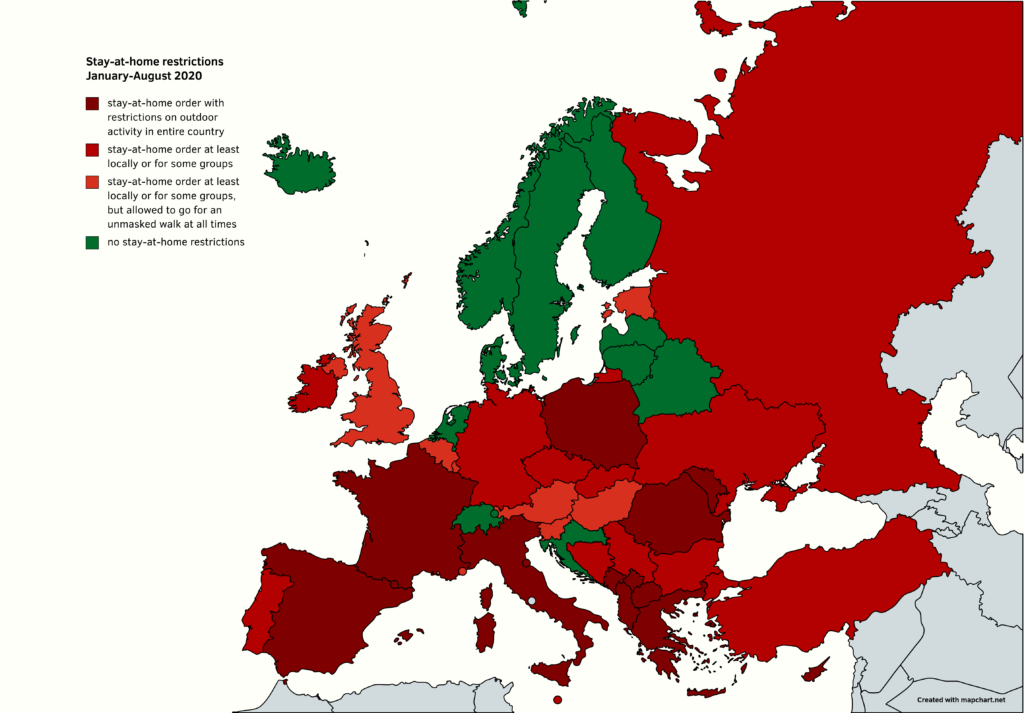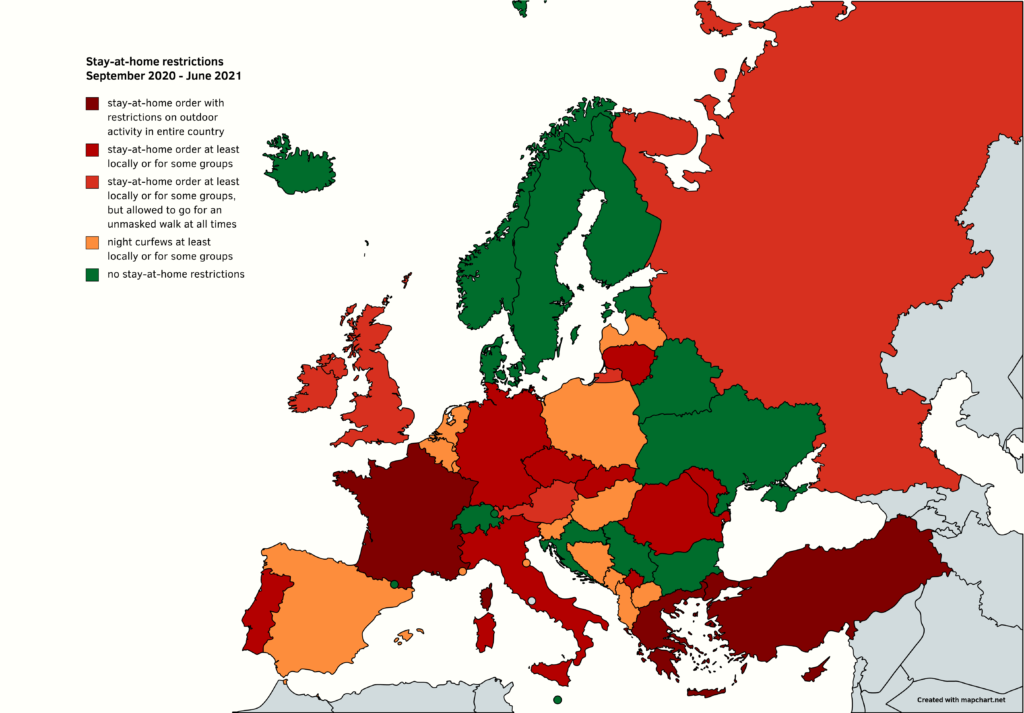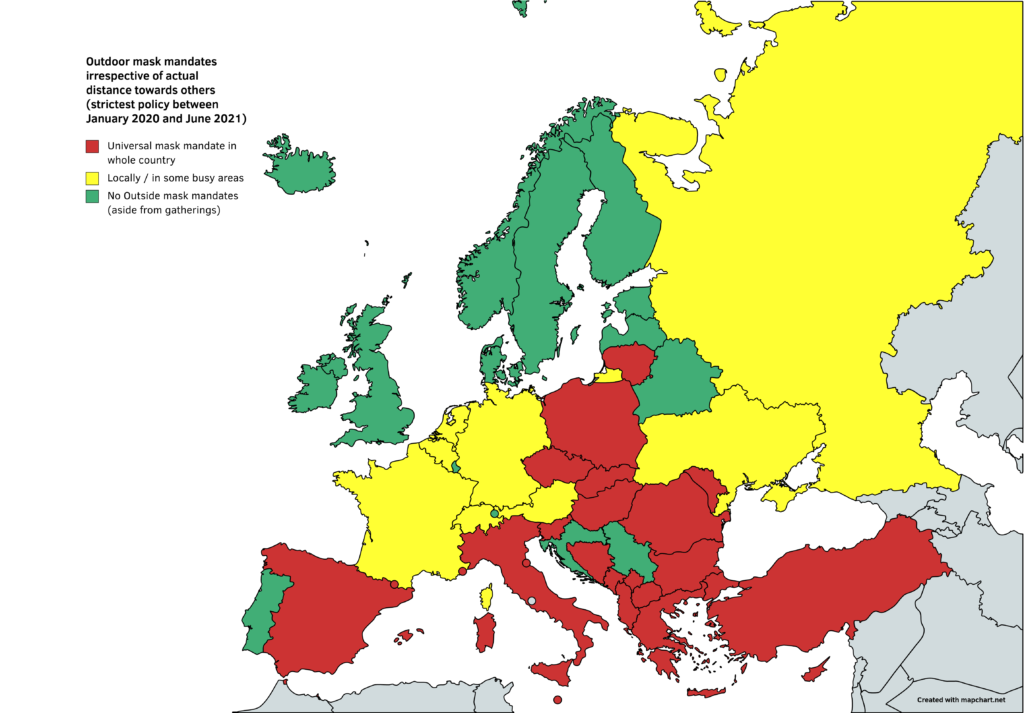For the following maps I classified all European countries in different categories, based on the data I collected on stay-at-home restrictions. Countries are classified according to the strictest restrictions that were in place during the covered time. I treated the first wave of the pandemic separately because many countries changed their stay-at-home policies after the first lockdown. As an end for the “first wave” I chose 31 August 2020. At that time, case numbers were low everywhere in Europe and most stay-at-home orders imposed during spring had ended.
Out of the five categories, the categories for no stay-at-home restrictions and only night curfews are probably the most straight forward. Countries that had all-day stay-at-home orders were grouped in three different categories: Those with all-day stay-at-home orders restricting outdoor activities at least locally or for some groups were grouped in one category. I created another category for countries that had all-day stay-at-home orders at least locally or for some groups but that nonetheless allowed going out to take a walk at all times without further conditions, such as following a timetable to go out, applying for permission first, or having tested negative. These countries could have still restricted outdoor activities to a certain radius around the place of residence. A last category includes only countries that had strict stay-at-home orders in the entire country that either did not allow for physical activities such as going for a walk, or that only allowed these under very limiting conditions, e.g. for an hour a day, or after filling a certain form.
To download the dataset including all sources, follow this link. Please take all information you can find here with caution. I did my best to gather all available public information, but I wanted to rely as little as possible on automatic translation. Thus data is likely incomplete especially for countries that don’t speak any Germanic or Romanic language. There might be local stay-at-home orders missing if they have not been reported on any English news site. I will correct and update the data if I take note of any missing policies. Please write me an e-mail if you find any inaccurate or incomplete information!

During the first wave, only 12 European countries did not impose any stay-at-home restrictions at least locally: Belarus, Croatia, Denmark, Finland, Iceland, Latvia, Liechtenstein, Lithuania, the Netherlands, Norway, Sweden, and Switzerland. It shall be noted that Croatia and Finland restricted the free movement of residents more than the other countries in this category. Croatia did not allow people to leave their municipality without a valid reason for around one month. Finland restricted the travel from and to the capital region for about three weeks in March and April of 2020.
In several countries, no national stay-at-home order was issued, but such restrictions were in place locally, often in municipalities with many cases of Covid-19. These local stay-at-home orders were often labelled “quarantine” despite affecting whole populations and not individuals. These local lockdowns were often accompanied with tough travel restrictions in and out of the affected areas. Countries in which stay-at-home orders were only in place for some towns were Bulgaria and Estonia. In the case of Estonia, it was allowed go for a walk within the locked down islands.
In Germany and Russia, some states/provinces have issued stay-at-home orders, but others did not. In the case of Russia, I could not find a lot of information in English, so it might be the case that there was indeed a stay-at-home order in all of Russia. There was certainly one in place in most states. In Germany, 6 of 16 states issued stay-at-home orders that nonetheless allowed for unlimited individual outdoor activities such as going for a walk. In some German municipalities, stricter lockdown rules were in place that did not allow to go for a walk.
Several countries issued a stay-at-home order but allowed for going for a walk or exercising outdoors, at least within a certain distance from home. This was the case for Austria, Belgium, Hungary, Luxembourg, Monaco, Slovenia, and the United Kingdom (yet in Wales that was only allowed once a day). In Czechia and Slovakia, it was also allowed to go out for a walk at all times, but masks had to be worn outside at all times.
In other countries, outdoor exercise was accepted as a reason to leave the house only under strict conditions. In France, people were allowed to leave for one hour a day within 1 km around their house and they had to carry a document that indicates the reason for movement and further information. In Italy and Greece, people were also allowed to leave for physical activity in close proximity from home, carrying a similar form. In Cyprus, people were allowed to leave their house once a day within close proximity around their house and carrying a form.
In some countries, the strictest stay-at-home restrictions only applied for some population groups. In Turkey, people aged 65 or older or 20 or younger, and those who suffer chronic illnesses had to stay home. In Ireland and Portugal, a stay-at-home order applied to everyone, but those under 70 and without relevant medical conditions were allowed to move within a close circle around their home. In big parts of the country, there were stay-at-home orders for the rest of the population, too. In Bosnia and Herzegovina and Serbia, the whole population was restricted to go out at night, but only those 65 or older (and under 18 in parts of Bosnia and Herzegovina) were restricted from going out during the day. In Ukraine, only persons over 60 were mandated to stay home. In Malta, a stay-at-home order applied to persons over 65, pregnant women, to persons with certain medical preconditions, and to persons living with members of the aforementioned groups.
A strict stay-at-home order for the whole population (sometimes with additional restrictions for older people), not allowing for outdoor activities was in place in Albania, Andorra, Kosovo, San Marino, Moldova, Montenegro, Northern Cyprus, North Macedonia, Poland, Romania, and Spain.

When Covid-19 cases surged again in late 2020, most governments imposed tough restrictions on freedom of movement again. Many countries’ policies differed from those in the first wave however. The most striking difference is that many countries introduced night curfews. In the first wave, only very few countries (Bosnia and Herzegovina, Serbia) used curfews, and they came together with a strict all-day stay-at-home order for risk groups. Many countries that had complete stay-at-home orders during the first wave changed to only restricting movement at night: Albania, Belgium, Bosnia and Herzegovina, Hungary, Luxembourg, Monaco, Montenegro, North Macedonia, San Marino, Slovenia, Spain. Poland is a special case as it only had a night curfew on New Year’s Eve, so it doesn’t fit perfectly in this list, but it would also not fit in the category of countries that never put restrictions on being outside. Two countries that did not have any stay-at-home restrictions during the first wave also introduced night curfews, namely the Netherlands and Latvia. In Latvia, the curfew was only in place during weekends. Nearly all countries that issued curfews also introduced mask mandates even when outdoors and not close to others. Such mandates put restrictions on being outside and they could easily be rephrased as “stay at home – unless you wear a mask”. As mask mandates are generally regarded as different from stay-at-home restrictions, I decided against referring to them as such here though. Of all the countries in the curfew category, the only ones that did not introduce country-wide outside mask mandates were the three Benelux countries (aside for some busy streets in Belgium) and Latvia.
Tier systems are another common change between the initial response and policies tackling the second and third wave of the pandemic. Many governments designed policies that automatically introduced restrictions on provinces or municipalities once the number of cases per capita exceeds a certain threshold. Very often, the thresholds were set low enough that at times the entire country was affected by the strictest policies.
Most of the other countries that did not have mandatory stay-at-home orders during the first wave also didn’t introduce any during the second and third wave: Belarus, Croatia, Denmark, Finland, Iceland, Liechtenstein, Norway, Sweden, and Switzerland. More countries joined this category after the first wave: Bulgaria and Estonia already had only local stay-at-home orders during the first wave and refrained from introducing any stay-at-home restrictions afterwards. Only in parts of Bulgaria, and for a short time, it was mandated to wear masks outdoors. The Serbian government announced it would introduce a new curfew on 7 July 2020, but some two weeks after a disputed national election, this sparked protests and riots and the government refrained from further pursuing this plan. Until today, Serbia has never reintroduced stay-at-home restrictions. Ukraine and Malta both had stay-at-home orders only for risk groups in the first wave, but never introduced such regulations again. Malta had a universal outdoor mask mandate though, and in the Ukraine this was the case in some regions. Andorra had a stay-at-home order during the first wave, but I found no information about any such order or curfew during the winter of 2020/21. Andorrans had to wear masks outside at all times, however. Finally, Poland almost qualified for this category, but did not due to the New Year’s Eve curfew and also issued a universal mask mandate.
The only country that changed from having no stay-at-home restrictions in the first wave to an all-day stay-at-home order in the second was Lithuania. People were nonetheless allowed to go for a walk, but only under the condition that they wore a mask unless outside towns and villages, where a distance of 20 metres to others could be ensured.
In Austria and the United Kingdom, stay-at-home orders were in force both in spring of 2020 and in winter of 2020/21 but it was allowed to go out for exercise at all times. The Austrian regulations explicitly allowed for “outdoor leisure activities”. In the UK, people were only allowed to go for a walk or exercise in “their local area” whose exact radius was sometimes disputed. Ireland had a complete stay-at-home order for risk groups during the first wave, but allowed everyone outdoor activities within 5 km around their house during the second wave. Lockdown policies in Russia varied much by region and there is little information in English for places other than Moscow and St. Petersburg. In Moscow, a stay-at-home order for people over 65 years was put in place during the winter of 2020/21, but the elderly were allowed to go out for unlimited walks.
In the Czech Republic, a stay-at-home order allowing for individual exercise was passed in both waves, but in the second it was accompanied by stricter night curfews that did not allow for such exceptions. It was also mandatory to wear masks outdoors. Rules were similar in Slovakia with an outside mask mandate and a strict night curfew, but additionally, a negative test was necessary for everyone between 15 and 65 to go outside during the day.
In Germany, only the state of Bavaria and few municipalities in other states imposed an all-day stay-at-home order in the winter of 2020/21, allowing for physical activity as a reason to leave the house. In all of Germany, night curfews were applied if the local incidence exceeded a defined threshold. Furthermore, many municipalities issued outside mask mandates, mostly only for “busy streets”, but in many cases this covered the entire city centre.
Romania, too, had no nationwide stay-at-home order, but many municipalities were “quarantined”, i.e. put under a local stay-at-home order. Nationwide, a curfew and an outside mask mandate were in place.
In Moldova, a stay-at-home order for persons over 63 years of age was in place from the first wave and I found no evidence that it ever ended. Locally, stay-at-home orders for the entire population were issued in 2021. A curfew and a universal outside mask mandate applied for the whole country.
In Kosovo, persons older than 65 were only allowed to go out during two time slots in the morning and afternoon. A curfew and a universal outside mask mandate applied for the whole country.
In Italy, regions with a high incidence of Covid-19 were put under a stay-at-home order. Outdoor exercise or going for a walk in the close vicinity around home was allowed only after filling a form stating the reason for circulation. At night, a curfew applied nationwide that did not allow for such exceptions. Masks had to be worn across the territory.
Due to the more localized approach of tier systems, only four territories reached the strictest category during the second and third wave of the pandemic in Europe, i.e. going out for a walk was prohibited across the entire territory at some point. France allowed for outdoor activities, but only for 1 hour a day within 1 km around the place of residence. Wearing masks outdoors was mandatory in most of the country. On the island of Cyprus, a stay-at-home order and an outside mask mandate was imposed both by the internationally recognized government in the South as in the Turkish Republic of Northern Cyprus. In the South, it was allowed to go out for physical activity, but it was only allowed to go out twice a day in total, and only after sending a text message to a government number. For Turkey, I found no source about whether the stay-at-home restrictions for over 65-year olds have ever been lifted after the first wave. Additionally, minors were not allowed to leave the house without at least one of their parents. After many months with curfews and further restrictions, including a universal mask mandate, in the spring of 2021, Turkey banned leaving the house for physical activity for the whole population and at all times again. In Greece, leaving the house was only allowed after applying for permission by sending a text message to a government number. Physical exercise was allowed outside in the proximity of one’s house. There was a universal mask mandate in place too, with some exceptions.
The map below shows which countries ever introduced outside mask mandates. Indoor mask mandates are not covered and to the best of my knowledge, Sweden is the only country where indoor mask mandates were never introduced at least locally. There are other countries that never introduced a national indoor mask mandate though, like Finland and Belarus.

As my research was more focused on explicit stay-at-home policies, my data on outside mask mandates might be somewhat incomplete. It was also often difficult to interpret news reports that stated that wearing masks had been mandated in “all public places” for instance. Policies in countries with local outside mask mandates vary significantly: For example, the Netherlands only had outside mask mandates for about one month in few very busy shopping streets whereas in Germany, masks had been mandated in whole towns. I also know from anecdotal reports that the enforcement of mask mandates varies dramatically, and probably the same holds for stay-at-home orders. While my maps and data reflect the best knowledge I could gain of the legal situation in countries, some places only had very strict rules on paper but didn’t enforce them strictly.